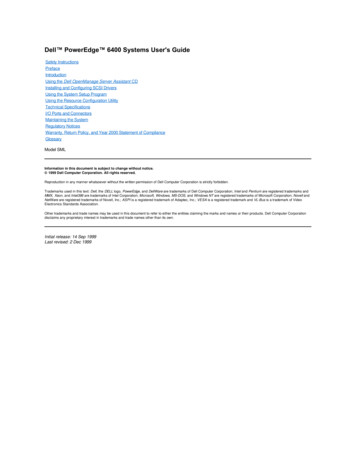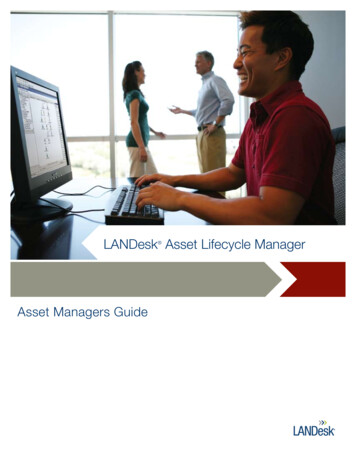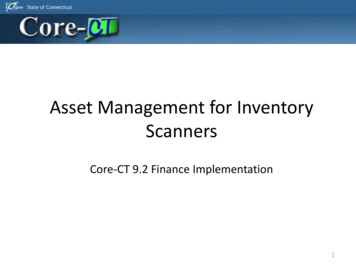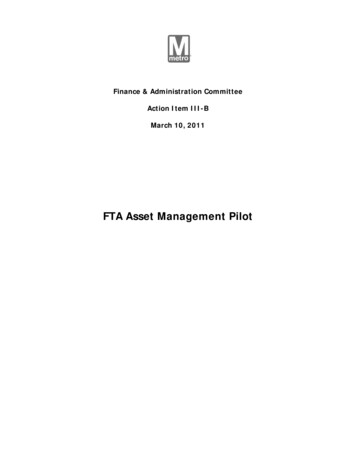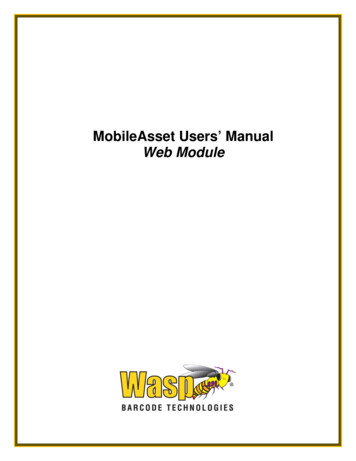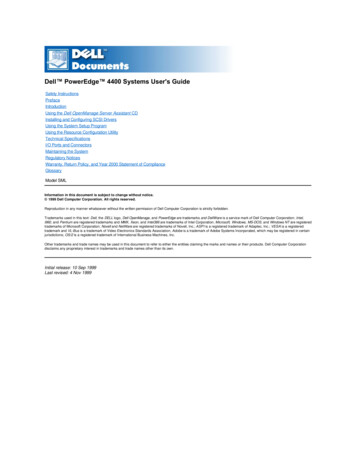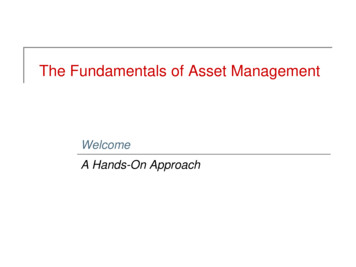
Transcription
The Fundamentals of Asset ManagementWelcomeA Hands-On Approach
AGENDA Day 1Welcome, Introductions & Housekeeping Details“Storyline” Introduction, Background And ContextOverview Of Fundamental Concepts & Core PracticesThe Storyline: Tom’s Really Bad DayCore Question 1: What Is The Current State Of My Assets?Core Question 2: What Is My Required “Sustainable” Level Of Service?Review of Key Slides; Discussion / Q & ADay 2 Core Question 3: Which Assets Are Critical To Sustained Performance?Core Question 4: What Are My Minimum “Life-cycle-cost” CIP and O&M Strategies?Core Question 5: Given The Above, What Is My Best Long-term Funding Strategy?Focus Topic 1: Deploying An AAM ProgramFocus Topic 2: Meeting The IT Challenge – Toward An Enterprise Asset ManagementSystem (EAMS) Summary, Addressing Your Questions, CommentsFundamentals of Asset Management2
Drawing from the AM Knowledge BaseThis workshop is produced by GHD Inc.Fundamentals of Asset Management Australian-based international company with over100offices worldwide 6500 management consultants, engineers, scientists,planners, architects Recognized as a world leader in advanced assetmanagement – over 25 years Literally, “wrote the book” on Best Practices Hundreds of engagements over two decades3
Our ―Faculty‖Mr. Steve Allbee USEPA Project Director, Gap Analysis;Primary author, USEPA’s The Clean Water and Drinking WaterInfrastructure Gap Analysis;30 years EPA - development of financing programs;BA, MA, MPA.Mr. Duncan Rose Principal Consultant; AM Technical Director – GHD Inc;Former city/county manager;Co-author of WEF’s Managing the Water & Wastewater Utility;30 years state & local management;Adjunct Faculty, Florida State University, Askew School ofPublic Policy and Administration;BA, MSP, MAPA.Fundamentals of Asset Management4
By the end of this workshop you should be able toaddress these five questionsWhat isAM?Why doAM?Fundamentals of Asset ManagementWhat“deliverables”do I get?How todo it?How do Imoveforward?5
The Fundamentals of Asset ManagementExecutive OverviewA Hands-On Approach
Emerging utility business conditions Increasing demand for utility servicesDiminishing resourcesLeveling of production efficienciesIncreasing restrictions on outputAging infrastructureResult: increasingly expensive treatment optionsFundamentals of Asset Management7
Emerging utility business conditions Aging customer baseDiminishing technical labor poolLarger and more sophisticated facilitiesLoss of knowledge with personnel retirementsPublic resistance to rate increasesResult: increasingly complex management environmentFundamentals of Asset Management8
Changing utility business environment Demand to do more with existing resourcesNeed to make every dollar work – to better use capitaland operating budgetsMove from reactive to proactive work environmentFundamentals of Asset Management9
A paradigm shift Transition from building and operating to managingassets Extending asset lifeOptimizing maintenance and renewalDeveloping accurate long-term funding strategiesSustain long term performance!Fundamentals of Asset Management10
Infrastructure is the foundation to sustainedquality of lifeFundamentals of Asset Management11
Consequences of asset failure can be severeFundamentals of Asset Management12
Asset management improves Decision making throughout the life cycle of the asset Acquisition Operation Maintenance RenewalResulting in lowest total cost of ownershipFundamentals of Asset Management13
This training describes What is asset management?Why do it?What deliverables do I get from it?What are the steps?How do I move my organization forward?Fundamentals of Asset Management14
What, then, is asset management (AM)? Systematic integration of advanced and sustainablemanagement techniques into a management paradigmor way of thinking, withPrimary focus on the long-term life cycle of the assetand its sustained performance, rather than on shortterm, day-to-day aspects of the assetFundamentals of Asset Management15
Views on asset management – a framework Asset management canbe thought of as anobject - a box orframework Following is a briefcharacterization of 8different views on assetmanagement These views make upthe frameworkFundamentals of Asset Management16
View 1: Definition - asset management Management paradigm and body of managementpractices Applied to the entire portfolio of infrastructure assets atall levels of the organization Seeking to minimize total costs of acquiring, operating,maintaining, and renewing assets Within an environment of limited resources While continuously delivering the service levelscustomers desire and regulators require At an acceptable level of risk to the organizationFundamentals of Asset Management17
View 2: Life cycle business teSupport processes: Demand management Knowledge of assets CIP validation Accounting & economics Condition & performance MaintainFundamentals of Asset ManagementmonitoringBusiness risk exposureHuman resourcemanagementReview & continuousimprovement18
View 3: Core AM program elementsInformationSystemsLifecycleProcess &PracticesData &KnowledgeTotal sServiceDeliverySustainable, best value service deliveryFundamentals of Asset Management19
View 4: Management frameworkAsset ManagementBusiness ProcessesAsset ManagementPlansStrategic InitiativesAnnual BudgetsOperating BudgetFundamentals of Asset ManagementCapital Budget20
View 5: Five core questions1.What is the current state of my assets? 2.What is my required level of service (LOS)? 3. How does it fail? How can it fail?What is the likelihood of failure?What does it cost to repair?What are the consequences of failure?What are my best O&M and CIP investment strategies? 5.What is the demand for my services by my stakeholders?What do regulators require?What is my actual performance?Which assets are critical to sustained performance? 4.What do I own?Where is it?What condition is it in? What is its performance?What is its remaining useful life?What is its remaining economic value?What alternative management options exist?Which are the most feasible for my organization?What is my best long-term funding strategy?Fundamentals of Asset Management21
View 6: AM plan 10-step re ModesDetermineResidualLifeDetermineLife Cycle &ReplacementCostsSet TargetLevels ofService (LOS)DetermineBusiness zeCapitalInvestmentDetermineFundingStrategyBuild AMPlanFundamentals of Asset Management22
View 6: AM plan 10-step processSystem Layout;Data Hierarchy,Standards, andInventoryConditionAssessmentProtocol; RatingMethodologiesExpected LifeTables;Decay CurvesValuation; LifeCycle CostingDemand Anal.;BalancedScorecard;Perform. tion,Failure ModesDetermineResidualLifeDetermineLiveLife Cycle &ReplacementCostsSet TargetLevels ofService (LOS)DetermineBusiness zeCapitalInvestmentDetermineFundingStrategyBuild AMPlanFMECA;Business RiskExp.; DelphiTechniquesRoot Cause;RCM; PdM;ORDMB/C AnalysisConfidence LevelRating; StrategicValidation;ORDMRenewalAnnuityAsset Mgmt Plan;Policies andStrategy;Annual BudgetFundamentals of Asset Management23
View 7: Seven principles of asset management1.2.3.The ―Value Added/Level of Service‖ Principle—assets exist to deliver servicesand goods that are valued by the customer-stakeholder; for each consumerstakeholder there is a minimum level of service below which a given service isnot perceived as adding value.The ―Life Cycle‖ Principle—all assets pass through a discernable life cycle, theunderstanding of which enhances appropriate management.The ―Failure‖ Principle—usage and the operating environment work to breakdown all assets; failure occurs when an asset can not do what is required by theuser in its operating environment.4.The ―Failure Modes‖ Principle—not all assets fail in the same way.5.The ―Probability‖ Principle—not all assets of the same age fail at the same time.6.The ―Consequence‖ Principle—not all failures have the same consequences.7.The ―Total Cost of Ownership‖ Principle—there exists a minimum optimalinvestment over the life cycle of an asset that best balances performance andcost given a target level of service and a designated level of risk.Fundamentals of Asset Management24
View 8: Enterprise asset management planExecutiveSummaryState of the AssetsSection - 1Levels of ServiceSection - 2Growth & DemandSection - 3Lifecycle ManagementSection - 4RenewalO&MManagementStrategiesSection - 6Risk ProfileSection - 5AugmentationFinancial PlanningSection - 7Business Improvement PlanSection - 8Fundamentals of Asset Management25
The enterprise asset management planFundamentals of Asset Management26
Inside the AM frameworkLevel 3Level 2Level 1Condition AssessmentBusiness Risk Exposure27Fundamentals of Asset Management
Inside the AM frameworkLevel 3Level 2Level 1Condition AssessmentBusiness Risk Exposure28Fundamentals of Asset Management
Inside the AM frameworkLevel 3Level 2Level 1Condition AssessmentBusiness Risk Exposure29Fundamentals of Asset Management
Three fundamental management decisions1.2.3.What are my work crews doing, where are they doingit—and why?What CIP projects should be done—and when?When should I repair, when should I rehabilitate, andwhen should I replace?These decisions typically account for over 80% of autility’s annual expendituresFundamentals of Asset Management30
Understanding how our assets failYin-yang of asset failureStressFundamentals of Asset ManagementResistanceto Stress31
Understanding how our assets failPipe failureSoil characteristics, groundwaterGalvanic actionPhysical loadsPipe attributesInternal corrosionBedding conditionFundamentals of Asset Management32
Understanding how our assets failInitial design capabilityManaged assetdeterioration curveManagementzoneMinimal performance levelPoorPerformanceExcellentManaging asset deteriorationDecreasingTimeInherent assetdeteriorationcurveIncreasing―Failure is the inability of any asset to do what users want it do to.‖John MoubrayFundamentals of Asset Management33
Understanding how our assets failExcellentMonitoring performance is a key to reliabilityPerformanceDecay curveVibrationOil lossNoisePoorHeatFailureDecreasingFundamentals of Asset ManagementTimeIncreasing34
Understanding how our assets failExperience indicates Failure can be subjected to systematic study – ascience 30-70% of equipment maintenance activity is typicallymisdirected – it is not cost effectively deterring failureFundamentals of Asset Management35
Understanding how our assets failFrom the science of failure - tools for proactivemanagement Root cause analysis Failure mode, effects, and criticality analysis (FMECA) Condition-based monitoring, failure/survival curves Predictive maintenance (PdM) Proactive maintenance (zero breakdown, reliabilitycentered maintenance, total productive maintenance) Reliability centered management (design, O&M)AM is all about managing the potential to failFundamentals of Asset Management36
Our investment toolkit MaintenanceRenewal: Major Repair – repair beyond normal periodic maintenance, relativelyminor in nature, anticipated in the long-term operation of the asset;no enhancement of capabilities; typically funded by operating budget Refurbish/Rehabilitate– replacement of a component part or parts orequivalent intervention sufficient to return the asset to level ofperformance above minimum acceptable level; may include minorenhancement of capabilities; typically funded out of capital budgets Replace Without enhancement – substitution of an entire asset with a newor equivalent asset without enhancement of capabilities With enhancement - substitution of an entire asset with a new orequivalent asset with enhanced capabilities―Augmentation‖Fundamentals of Asset Management37
Failure mode-based management logicFailuresAreSignificantCannot Be Preventedby MaintenanceAre NotSignificantCan Be Preventedby MaintenancePreventionEffective?YesRedesign, Replace,OverhaulSchedule forMaintenanceNoRepair & MonitorRun to Failure,RepairFundamentals of Asset Management38
Determining ―significant‖ failuresWhat is probability of failure? What is consequence of failure?HighBHigh probabilitylow consequenceD High probability-Probabilityhigh consequenceA Low probability-Business risk drives workprogram (O&M, CIP)low consequenceLowLowFundamentals of Asset ManagementConsequenceCLow probabilityhigh consequenceHigh39
The big pictureRisk-ConsequenceGrowth (New Assets)AugmentationLOSCustomerCapitalSystem RenewalSystem Improvements(Environmental, LOS)Cost ofServiceO&MMaintenance ProgramOperations andAdministrationFundamentals of Asset Management40
AM-oriented structureCustomer Service DemandsSustained PerformanceExecutive ManagementAM Thinking(AM Steering Committee)EngineeringOperationsFinanceFundamentals of Asset ManagementMaintenanceITAM Tools41
AM-based decisions produce real savingsFrom assessment of Australia’s advanced managementpractices, 20-30% future life cycle cost savingstypically is achievable for US water and wastewaterutilitiesWhere savings develop from Efficiency gains Cost avoidance (defer, eliminate, reduce) Cost effectiveness and redirectionFundamentals of Asset Management42
Making business case for AMFundamentals of Asset Management43
AM payoffs Reduced life cycle costsfrom better-focused(redirected) resource useBetter value-per-dollarspendingConfidence in decisionmakingFundamentals of Asset ManagementThe right work,the right investment,at the right time,for the rightreasons.44
Realistic expectations for AM Takes several years ofdetailed, nitty-gritty workto fully deploy Requires eventual buyin commitment of thewhole organization Needs upfrontinvestment to getstarted, with hiddenreturns for initial yearsFundamentals of Asset Management45
AM is a business model What we doWhy we do itHow we do itWhere we investWhat our costs areWhat our return isFundamentals of Asset Management46
Tom’s bad day Fundamentals of Asset Management47
Tom’s spreadsheetFundamentals of Asset Management48
Integration of 5 core questions with 10-step process1. What is the current state of my assets?2. What is my requiredlevel of ure ModesDetermineResidualLifeDetermineLife Cycle &ReplacementCostsSet TargetLevels ofService (LOS)DetermineBusiness zeCapitalInvestmentDetermineFundingStrategyBuild AMPlan3. Which assets 4. What are my best O&M and5. What is my best long-termare criticalfunding strategy?CIP investment strategies?to sustainedDecision makingperformance?Fundamentals of Asset Management49
The Bear and the ButterflyFundamentals of Asset Management50
View 8: Enterprise asset management plan . Executive Summary . Levels of Service . Section - 2 . State of the Assets . Section - 1 . Growth & Demand . Section - 3 . Business Improvement Plan . Section - 8 . Management Strategies . Section - 6 . Lifecycle Management . Se





